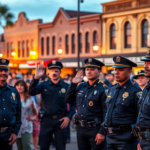Corpus Christi Woman Sentenced for Role in 2018 Edinburg Double Homicide
In a case that captured the attention of the entire Rio Grande Valley, Irene Navejar of Corpus Christi has been sentenced to five years in prison for her involvement in the “grisly” double homicide of a mother and son in Edinburg back in 2018. The sentencing brings a complex legal journey to a close, as the community recalls the chilling details of the crime.
The Crime and Its Aftermath
The gruesome incident dates back to April 2018 when 52-year-old Alejandro Salinas Sr. and his 73-year-old mother, Olivia Salinas, were found dead in their Edinburg mobile home. The Edinburg Police Department, who initially described the crime scene as “grisly,” discovered that Alejandro had been brutally beaten while Olivia had been choked to death. The bodies were so severely decomposed that authorities took time to identify them.
Soon after the discovery, Irene Navejar and her then-boyfriend Gabriel Keith Escalante were arrested in connection with the homicides. According to police records, the duo attempted to clean the crime scene with water and Clorox, a move that ultimately led to Navejar’s recent sentencing as she pled guilty to tampering with physical evidence. In exchange for her plea, the more severe charges of capital murder and murder were dropped.
Community Reaction in the RGV
The impact of the crime has been profound, not only because of its brutality but also due to its implications in the Rio Grande Valley. For Valley residents, this case is a stark reminder of the heinous crimes that can threaten community safety. Local resident and community advocate Lupe Martinez expressed a common sentiment: “It’s hard to think of our peaceful Valley having such dark spots. We hope justice brings some closure to the families affected and serves as a deterrent for future crimes.”
The specific nature of the crime has heightened community concerns regarding safety and security. In response, the Edinburg Police Department has emphasized its commitment to upholding law and order, working tirelessly to prevent similar incidents and build trust with local communities.
A Legal Perspective
The handling of this case, contrasted with that of Escalante who received a life sentence without parole, draws attention to the complexities inherent in the justice system. Navejar’s sentence, resulting from a plea deal, exemplifies the difficult balance courts must maintain between securing convictions and reflecting the degree of individual culpability.
District Attorney Ricardo Sanchez commented on the case, saying, “Our goal is always to seek justice in a way that is fair and proportionate. While no sentence can undo the harm caused, we hope this resolution brings a measure of peace to the victims’ families and the community.” Sanchez’s office continues to monitor cases with high RGV news profiles, ensuring they resonate rightly with the public’s sense of justice.
Implications for Future Cases
This case may influence how future legal proceedings are approached in the RGV, from the transparency of plea deals to considerations of community safety. As the Valley continues to grow and evolve, such cases might prompt localized reforms or initiatives aimed at strengthening community relations and preventing crime through education and intervention.
It also serves as a potential blueprint for handling high-profile cases that involve interstate dynamics, emphasizing inter-agency cooperation and clear communication channels between local law enforcement and judicial entities.
Resources for the Community
For those affected by or interested in related community issues, various resources are available to provide support and further information. Edinburg local government has announced it will host forums on public safety, which will also aim to foster dialogue between residents and authorities.
Additionally, victims and their families seeking support or guidance can reach out to local advocacy groups such as the RGV Crime Victims Coalition. Their representatives can provide both emotional support and information on victim rights within the Valley’s legal framework.
Conclusion
The sentencing of Irene Navejar marks a significant chapter in one of the Rio Grande Valley’s most disturbing criminal cases. As the region grapples with the psychological and social ramifications of such events, the focus remains on fostering a safer community where residents can thrive without fear. By learning from tragedies and supporting preventative measures, Valley residents and officials alike hope to create a future where the news is more about community interest and less about criminal disturbance.







